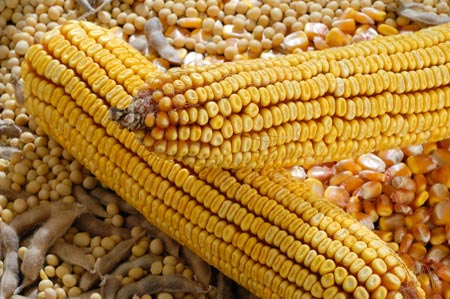 (Farm and Ranch Guide) – A high quality 2012 corn crop is finding a home in the United States, with exports staying below market expectations.
(Farm and Ranch Guide) – A high quality 2012 corn crop is finding a home in the United States, with exports staying below market expectations.
High test weight, protein levels and density, plus lower moisture are some of the attributes of the corn crop that was put up with minimal rainfall at harvest, according to the U.S. Grains Council’s Corn Harvest Quality Report. Test weight for the crop is averaging 58.8 pounds per bushel – more than 2 pounds per bushel above the criteria for No. 1 U.S. corn.
The USDA estimated the U.S. 2012 corn production at 10.725 billion bushels. The major uses for the 2012 crop included feed and residual at 4.15 billion bushels, and food, seed and industrial use – including ethanol use – at 5.85 billion bushels. Exports were estimated at 1.15 billion bushels in the November World Agricultural Supply and Demand Estimates (WASDE).
Ending stocks – ahead of the 2013 U.S. harvest – were estimated at 647 million bushels prior to the release of the December WASDE report. In general, anything under 1 billion bushels is considered bullish.
The market has responded negatively to the poor U.S. corn export numbers, though. As of Dec. 6, the USDA reported weekly export sales of 51,600 metric tons (2 million bushels), as the trade looked for South American corn available at lower prices.
Cumulative U.S. exports for the 2012 crop reached 42 percent of the USDA forecast as of Nov. 29, vs. 50.5 percent for the five-year average.
The markets on Dec. 6 traded with March at $7.525, May at $7.54, July at $7.48, September at $6.64 and December 2013 at $6.44 per bushel.
Compared with prices on Nov. 21, March was 12.5 cents higher, May was 14 cents higher, July was $17.5 cents higher, September was 20 cents higher, and December was 20.5 cents higher.
“A lot of the trade attention is now focused on South America,” said Al Kluis, commodity advisor, broker and president at Kluis Commodities, Wayzata, Minn. “There are some pretty major planting delays and crop development problems that have developed in Argentina.”
It is a wet spring in Argentina, and corn planting in general needs to be completed by Dec. 10.
Traders wondered if the USDA or Argentine sources intended to lower corn projections for Argentina – which would likely raise corn futures. Kluis said it was too soon to tell if the corn futures markets had put in a bottom.
“The corn futures have good support around $7.40, but they have not been able to close over $7.70 (per bushel),” he said. “They are locking in a trading channel between those two important support resistance levels.”
At one elevator in western Minnesota, cash corn on Dec. 6 traded at $7.21 per bushel with a basis of 31 cents under. Compared with the price on Nov. 21, the price was up 9 cents, and the basis was unchanged.
At this same elevator, cash corn traded on Dec. 10, 2009 for $3.18 and a basis of 76 cents under; Dec. 10, 2010 for $5.16 and a basis of 58 cents under; and Dec. 9, 2011 for $5.63 per bushel with a basis of 31 cents under.
Kluis suggested that corn traders will continue to watch the weather in South America, the current pace of corn exports, and the use of corn for ethanol.




